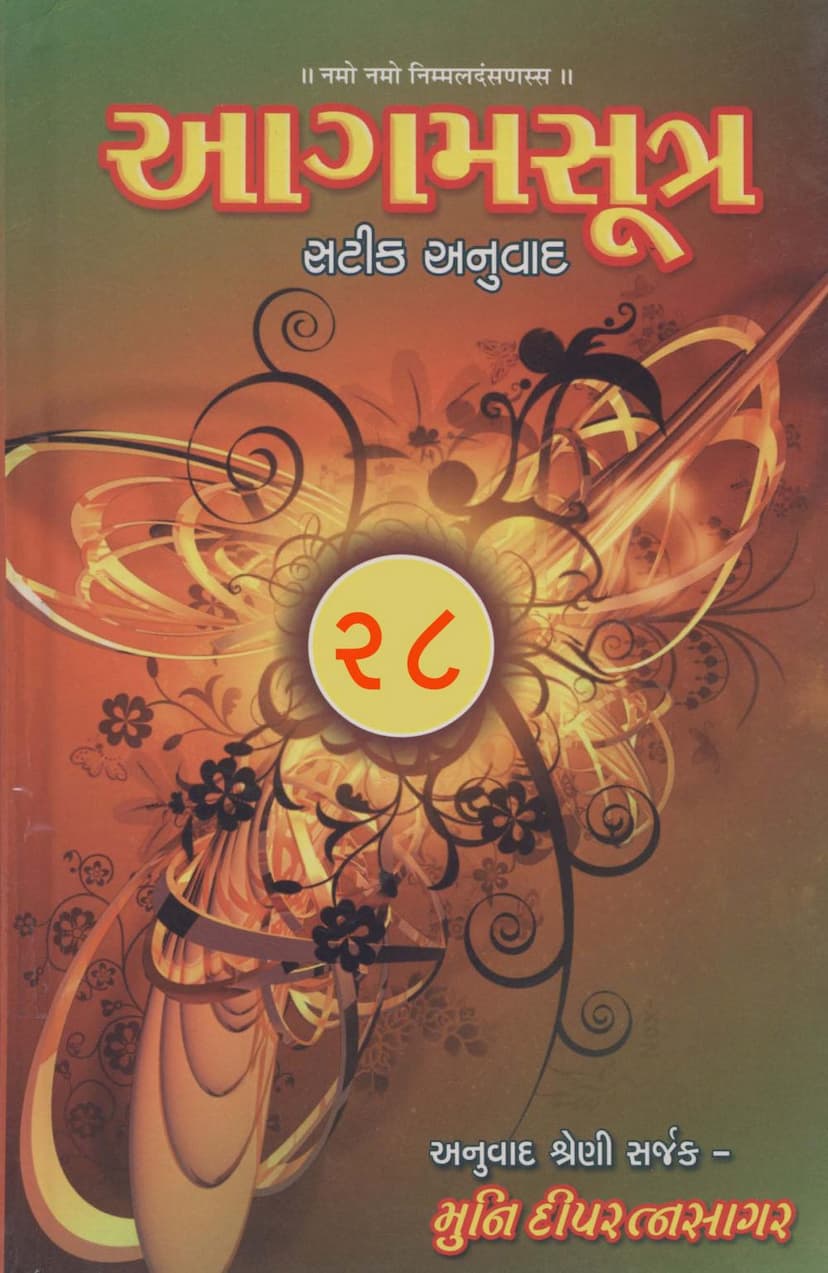Agam 27 Bhakta Parigna Sutra Satik Gujarati Anuvad
Added to library: September 1, 2025

Summary
Here is a comprehensive summary of the provided Jain text in English, focusing on the content related to the Bhaktaparigñā Sūtra:
This document is the 28th volume in a series titled "Agam Sūtra Sāṭik Anuvād" (Agam Sūtra with Commentary Translation), published by Deepratnasagar. The series is authored by Dipratnasagar and Deepratnasagar. This particular volume, Agam 27 Bhakta Parigna Sutra Satik Gujarati Anuvad, focuses on the Bhaktaparigñā Sūtra, which is part of the Jain Agamas.
Key Aspects and Content:
-
Purpose of the Series: The overall aim of the series is to provide a Gujarati translation with commentary of the Jain Agamas. This specific volume deals with the Bhaktaparigñā Sūtra, presented as a "Prakirṇaka Sūtra" (Miscellaneous Sūtra).
-
Author and Translator: The translation and commentary are credited to Muni Deepratnasagar. The project is supported by numerous donors and religious organizations, as detailed in the extensive acknowledgments section.
-
Content of Volume 28: Volume 28 includes:
- Nirayāvalikā (a collection of five Upānga Sūtras)
- Pushpikā
- Chatuḥśaraṇa
- Mahāpratyākhyāna
- Tandula Vaichārika
- Gacchāchāra
- Devendrastava
- Vṛṣṇidaśā
- Kalpavataṁsikā
- Puṣpacūlikā
- Ātura Pratyākhyāna
- Bhaktaparigñā (the main focus of this summary)
- Saṁstāraka
- Gaṇividhā
- Vīrastava
- Candravyadhaka
- (Ten plus one optional Payannā Sūtras)
-
Bhaktaparigñā Sūtra Translation (Page 16-19):
- The text begins by noting that while a commentary (Avachūrṇi) by Guṇaratnasūri exists for the Bhaktaparigñā Sūtra, the available version was considered incomplete, and thus, only a direct translation of the original verses (Gāthās) is provided.
- The translation presents the verses sequentially, numbered from 1 to 173.
- Core Themes of the Bhaktaparigñā Sūtra as translated:
- Introduction and Purpose: The sutra is presented as a teaching for the spiritual benefit of oneself and others, recited by Lord Mahāvīra. It emphasizes the preciousness of human life and the Jain teachings.
- Nature of Happiness and Suffering: The verses describe worldly happiness (of humans and deities) as ultimately sorrowful due to its impermanent and consequential nature. True happiness is sought in liberation (mokṣa).
- The Ideal of Jain Practice: The text stresses the importance of earnest effort in adhering to the teachings of the Jinas (Jain Tirthankaras), which include right knowledge (jñāna), right faith (darśana), right conduct (chāritra), and austerity (tapa).
- Types of Death and Renunciation (Samlekhanā): A significant portion discusses different forms of death, particularly those undertaken by ascetics. It categorizes death into various types, including 'Bhaktaparigñā' and 'Iṅgita'.
- Bhaktaparigñā as a Method of Renunciation: The sutra details the process of Bhaktaparigñā (literally, "acceptance of sustenance/food" in a renunciatory context), which is a form of voluntary fasting leading to death, undertaken with a pure mind and intention. It describes the mental preparation, the role of the Guru, and the rites involved.
- Qualities of a Practitioner: The text outlines the qualities of an individual suitable for Bhaktaparigñā, emphasizing detachment from worldly pleasures, absence of regret, adherence to vows, and a strong resolve for liberation. It highlights the importance of renouncing attachments, desires, and negative emotions like anger, pride, deceit, and greed.
- The Dangers of Indulgences and Attachment: The verses strongly warn against sensual pleasures, attachment to women, and the consequences of impure conduct, illustrating these points with examples and metaphors. The pursuit of worldly desires is depicted as leading to suffering and rebirth.
- The Power of Right Faith (Samyaktva): A central theme is the paramount importance of Samyaktva (right faith or perfect intuition). It is described as the ultimate treasure, invaluable in all realms, and the foundation for acquiring knowledge, austerity, and strength. Those who possess Samyaktva are considered fortunate and are destined for liberation.
- The Efficacy of Devotion (Bhakti): The sutra extols the power of devotion, particularly devotion to the Arhats, Siddhas, the doctrine, Acharyas, and Sadhus. It states that devotion alone is sufficient to avert misfortune and lead to ultimate happiness.
- The Ninefold Auspiciousness (Navapad): While not explicitly detailed in the translated verses provided here, the context of Jain practice suggests the underlying significance of the Navapada (Nine Houses of Auspiciousness).
- The Role of the Namaskāra Mantra: The text emphasizes the power of the Pañca Namaskāra mantra (Namo Arihantāṇaṁ, Namo Siddhaṁ, etc.) for spiritual progress and purification, particularly during the process of Bhaktaparigñā.
- Ethical Precepts: The translation includes detailed guidance on adhering to ethical principles such as non-violence (ahimsā), truthfulness (satya), non-stealing (asteya), celibacy (brahmacharya), and non-possession (aparigraha). It explains how violating these principles leads to suffering.
- The Process of Renunciation and Acceptance: The verses describe the disciple seeking permission from the Guru to undertake Bhaktaparigñā, the Guru's guidance on purification, vows, and the acceptance of the vow.
- Final Instruction and Counsel: The final verses offer profound advice from the Guru to the disciple, encouraging detachment, self-control, understanding the impermanence of worldly things, and unwavering devotion to the principles of Jainism.
-
Catalog Link and Publisher Information: The provided link is to jainqq.org, a resource for Jain literature. The publisher is Deepratnasagar, with contact details for their publishing house and printing press.
-
Scope of the Series: The document also includes information about other publications in the series, highlighting the extensive nature of their work in translating and publishing Jain Agamas and related literature, including dictionaries, commentaries, and historical accounts.
In essence, this volume of the Agam Sūtra series provides a Gujarati translation and commentary on the Bhaktaparigñā Sūtra, a significant text within Jainism that elaborates on the principles of renunciation, detachment, ethical conduct, and the path to spiritual liberation, particularly through the practice of voluntary fasting and death with full awareness.